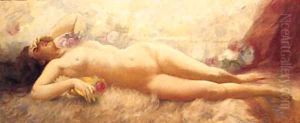Eduard Buchner Paintings
Eduard Buchner was a German chemist and zymologist, born in Munich on May 20, 1860. He is best remembered for his groundbreaking discovery of cell-free fermentation, a finding that significantly advanced the field of biochemistry and earned him the Nobel Prize in Chemistry in 1907. Before this discovery, it was widely believed that fermentation could only occur within living cells. Buchner's work demonstrated that enzymes could catalyze fermentation outside of cells, which was a radical departure from the prevailing scientific consensus of the time. Buchner's academic journey began at the Polytechnic School in Munich, where he initially studied engineering before switching to chemistry. He completed his doctoral studies under the guidance of Adolf von Baeyer at the University of Munich. After earning his doctorate, Buchner held various academic positions, including roles at the University of Kiel, the University of Tübingen, and the University of Berlin. In 1897, while working at the University of Berlin, Buchner conducted his famous experiment that demonstrated the fermentation of sugar into alcohol by extracts of yeast cells, thus proving that enzymes could facilitate chemical reactions outside of living organisms. His work laid the foundations for the fields of enzymology and industrial fermentation, impacting industries ranging from pharmaceuticals to food production. Despite the scientific community's initial skepticism, Buchner's findings were eventually recognized as a major milestone in biochemistry. Tragically, his career was cut short when he died on August 13, 1917, from injuries sustained while serving in World War I. Buchner's legacy continues to influence the field of biochemistry, emphasizing the importance of enzymes in biochemical processes.
